江苏大学研究生英语总结--下学期
- 格式:doc
- 大小:97.05 KB
- 文档页数:12
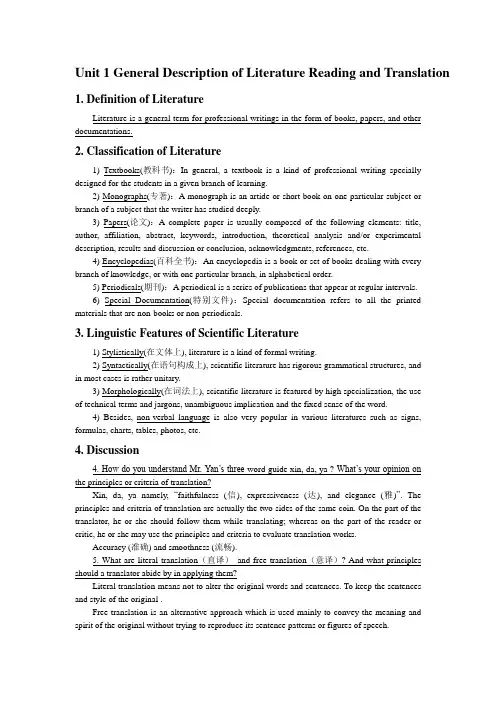
Unit 1 General Description of Literature Reading and Translation 1. Definition of LiteratureLiterature is a general term for professional writings in the form of books, papers, and other documentations.2. Classification of Literature1) Textbooks(教科书):In general, a textbook is a kind of professional writing specially designed for the students in a given branch of learning.2) Monographs(专著):A monograph is an artide or short book on one particular subject or branch of a subject that the writer has studied deeply.3) Papers(论文):A complete paper is usually composed of the following elements: title, author, affiliation, abstract, keywords, introduction, theoretical analysis and/or experimental description, results and discussion or conclusion, acknowledgments, references, etc.4) Encyclopedias(百科全书):An encyclopedia is a book or set of books dealing with every branch of knowledge, or with one particular branch, in alphabetical order.5) Periodicals(期刊):A periodical is a series of publications that appear at regular intervals.6) Special Documentation(特别文件):Special documentation refers to all the printed materials that are non-books or non-periodicals.3. Linguistic Features of Scientific Literature1) Stylistically(在文体上), literature is a kind of formal writing.2) Syntactically(在语句构成上), scientific literature has rigorous grammatical structures, andin most cases is rather unitary.3) Morphologically(在词法上), scientific literature is featured by high specialization, the useof technical terms and jargons, unambiguous implication and the fixed sense of the word.4) Besides, non-verbal language is also very popular in various literatures such as signs, formulas, charts, tables, photos, etc.4. Discussion4. How do you understand Mr. Yan’s three-word guide xin, da, ya ? What’s your opinion onthe principles or criteria of translation?Xin, da, ya namely, “faithfulness (信), expressiveness (达), and elegance (雅)”. The principles and criteria of translation are actually the two sides of the same coin. On the part of the translator, he or she should follow them while translating; whereas on the part of the reader or critic, he or she may use the principles and criteria to evaluate translation works.Accuracy (准确) and smoothness (流畅).5. What are literal translation(直译)and free translation(意译)? And what principles should a translator abide by in applying them?Literal translation means not to alter the original words and sentences. To keep the sentencesand style of the original .Free translation is an alternative approach which is used mainly to convey the meaning andspirit of the original without trying to reproduce its sentence patterns or figures of speech.In the application of literal translation, we should endeavor to rid ourselves of stiff patterns and rigid adherence to translation rules, trying to be flexible; while in the practice of free translation, we should be cautious of subjectivity, avoiding groundless affirmation or arbitrary fabrication.Unit 2 Professional Papers1. Definition of professional papersA professional paper is a typewritten paper in which professionals present their views and research findings on a chosen topic.2. Classification of professional papers1) Report Paper:The report paper summarizes and reports the findings of another on a particular subject.2) Research paper:A research paper can be intelligent, well informed, interesting, and original in its conclusions.3) Course Paper:Course papers are written after a specific course is learned or are designed at the end of a term, also called “term paper”.4) Thesis Paper:Unlike report papers, the thesis paper takes a definite stand on an issue. A thesis is a proposition or point of view that a writer or speaker is willing to argue against or defend.3. Linguistic Features of Professional Papers1) Formal Style(正式性):A professional paper deals with the study of some objective facts or problems, and the conclusion that is drawn should be based on relevant data, not on personal likes and dislikes. Generally speaking, formal writing sets an unusually high value on objectivity, meticulousness, accuracy, and restraint.2) Specialized Terms(专业性):The terms in professional papers are typically specialized.3) Rigid Sentence Structure(严谨的句式结构):The arguments in professional papers will be concisely and concretely.4) Formatted Elements(固定的内容格式):A complete professional paper usually has a regular format composed of the following elements: the title, author(s), affiliation(s), abstract, keywords, introduction, body of the paper (theoretical description including calculation, inference, reasoning, conclusion, etc. or experimental description including techniques, methods, materials, results and analysis, etc.), acknowledgments, appendices, references or bibliography, etc.5. Diction(1)This war is becoming the most important story of this generation.(event)这场战争将成为这一代人经历的最重大的事件。
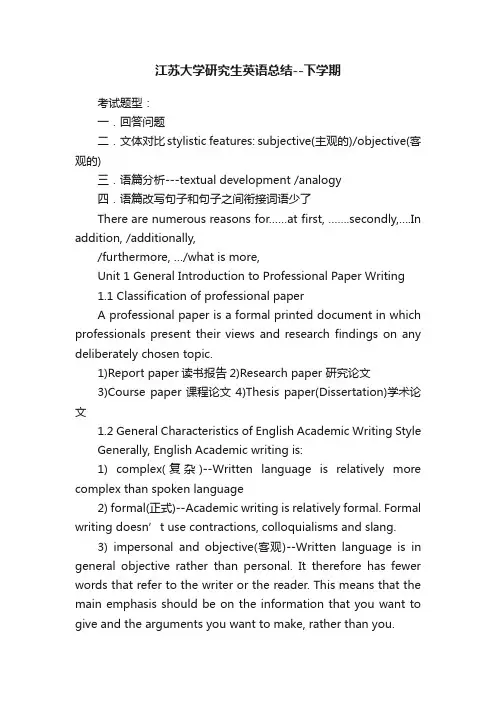
江苏大学研究生英语总结--下学期考试题型:一.回答问题二.文体对比stylistic features: subjective(主观的)/objective(客观的)三.语篇分析---textual development /analogy四.语篇改写句子和句子之间衔接词语少了There are numerous reasons for……at first, …….secondly,….In addition, /additionally,/furthermore, …/what is more,Unit 1 General Introduction to Professional Paper Writing1.1 Classification of professional paperA professional paper is a formal printed document in which professionals present their views and research findings on any deliberately chosen topic.1)Report paper读书报告2)Research paper 研究论文3)Course paper课程论文4)Thesis paper(Dissertation)学术论文1.2 General Characteristics of English Academic Writing StyleGenerally, English Academic writing is:1) complex(复杂)--Written language is relatively more complex than spoken language2) formal(正式)--Academic writing is relatively formal. Formal writing doesn’t use contractions, colloquialisms and slang.3) impersonal and objective(客观)--Written language is in general objective rather than personal. It therefore has fewer words that refer to the writer or the reader. This means that the main emphasis should be on the information that you want to give and the arguments you want to make, rather than you.4) explicit(清楚)--Academic writing is explicit about the relationships in the text. Furthermore, it is the responsibility of the writer in English to make it clear to the reader how the various parts of the text are related.5) accurate(准确)--Academic writing uses vocabulary accurately. Most subjects have words with narrow specific meanings.6) cautious or tentative(用词谨慎)7) responsible(负责)---Academic writing refers to information from a range of print, digital and other sources, all of which must be clearly referenced in your text references other writers’ work. Question & Exercises:Read the following two passages and try to find out the stylistic features of each.Answer:Compared with these two passages, I find that there are differences in styles,passage 1 is informal, subjective, for example: ―I’m......‖,―don’t......‖While the second passage is a scientific research paper, it’s formal, objective and complex, for example,(长句,被动语态等)(subjective---objective, simple---complex, for example......) Unit 2 Title, Author/Affiliation and Keywords2.1 Titles2.1.1. General functions1). Generalizing the Text (总结全文)2). Attracting the Reader (吸引读者)3). Facilitating the Retrieval (方便检索)2.1.2.Linguistic Features做分析题时候,可以根据下面的格式进行分析。
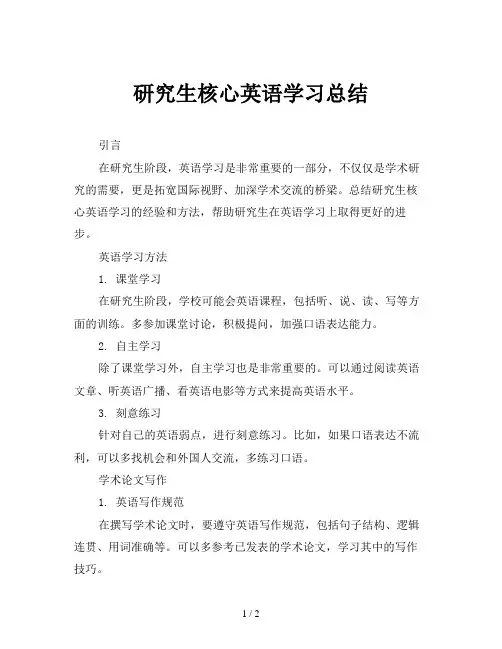
研究生核心英语学习总结
引言
在研究生阶段,英语学习是非常重要的一部分,不仅仅是学术研究的需要,更是拓宽国际视野、加深学术交流的桥梁。
总结研究生核心英语学习的经验和方法,帮助研究生在英语学习上取得更好的进步。
英语学习方法
1. 课堂学习
在研究生阶段,学校可能会英语课程,包括听、说、读、写等方面的训练。
多参加课堂讨论,积极提问,加强口语表达能力。
2. 自主学习
除了课堂学习外,自主学习也是非常重要的。
可以通过阅读英语文章、听英语广播、看英语电影等方式来提高英语水平。
3. 刻意练习
针对自己的英语弱点,进行刻意练习。
比如,如果口语表达不流利,可以多找机会和外国人交流,多练习口语。
学术论文写作
1. 英语写作规范
在撰写学术论文时,要遵守英语写作规范,包括句子结构、逻辑连贯、用词准确等。
可以多参考已发表的学术论文,学习其中的写作技巧。
2. 查阅英文文献
学术研究需要大量的英文文献支撑,因此要勤于查阅英文文献,获取最新的研究成果和观点。
学术交流
1. 学术会议
参加学术会议是提高英语交流能力的好机会。
在会议上可以和来自不同国家的学者进行交流,扩展自己的学术视野。
2. 学术讲座
多参加学术讲座,聆听专家学者的报告,提升自己的专业知识。
在讲座后可以和讲者交流,展示自己的学术见解。
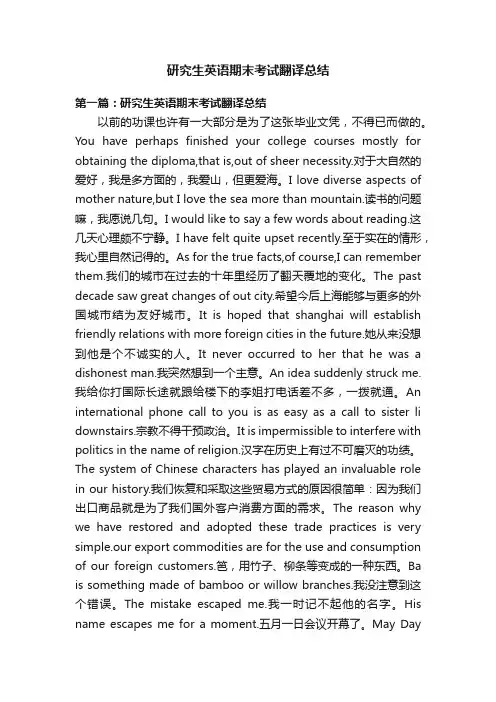
研究生英语期末考试翻译总结第一篇:研究生英语期末考试翻译总结以前的功课也许有一大部分是为了这张毕业文凭,不得已而做的。
You have perhaps finished your college courses mostly for obtaining the diploma,that is,out of sheer necessity.对于大自然的爱好,我是多方面的,我爱山,但更爱海。
I love diverse aspects of mother nature,but I love the sea more than mountain.读书的问题嘛,我愿说几句。
I would like to say a few words about reading.这几天心理颇不宁静。
I have felt quite upset recently.至于实在的情形,我心里自然记得的。
As for the true facts,of course,I can remember them.我们的城市在过去的十年里经历了翻天覆地的变化。
The past decade saw great changes of out city.希望今后上海能够与更多的外国城市结为友好城市。
It is hoped that shanghai will establish friendly relations with more foreign cities in the future.她从来没想到他是个不诚实的人。
It never occurred to her that he was a dishonest man.我突然想到一个主意。
An idea suddenly struck me.我给你打国际长途就跟给楼下的李姐打电话差不多,一拨就通。
An international phone call to you is as easy as a call to sister li downstairs.宗教不得干预政治。
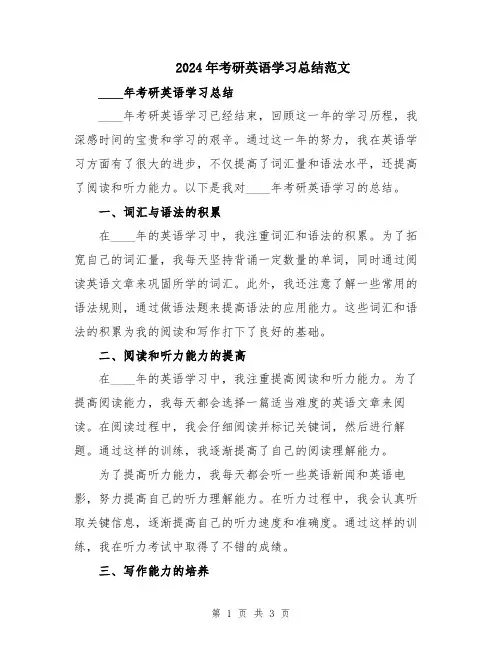
2024年考研英语学习总结范文____年考研英语学习总结____年考研英语学习已经结束,回顾这一年的学习历程,我深感时间的宝贵和学习的艰辛。
通过这一年的努力,我在英语学习方面有了很大的进步,不仅提高了词汇量和语法水平,还提高了阅读和听力能力。
以下是我对____年考研英语学习的总结。
一、词汇与语法的积累在____年的英语学习中,我注重词汇和语法的积累。
为了拓宽自己的词汇量,我每天坚持背诵一定数量的单词,同时通过阅读英语文章来巩固所学的词汇。
此外,我还注意了解一些常用的语法规则,通过做语法题来提高语法的应用能力。
这些词汇和语法的积累为我的阅读和写作打下了良好的基础。
二、阅读和听力能力的提高在____年的英语学习中,我注重提高阅读和听力能力。
为了提高阅读能力,我每天都会选择一篇适当难度的英语文章来阅读。
在阅读过程中,我会仔细阅读并标记关键词,然后进行解题。
通过这样的训练,我逐渐提高了自己的阅读理解能力。
为了提高听力能力,我每天都会听一些英语新闻和英语电影,努力提高自己的听力理解能力。
在听力过程中,我会认真听取关键信息,逐渐提高自己的听力速度和准确度。
通过这样的训练,我在听力考试中取得了不错的成绩。
三、写作能力的培养在____年的英语学习中,我注重培养写作能力。
为了提高写作水平,我每天都会写一篇英语作文,并请老师或同学进行修改和指导。
同时,我还关注一些经典范文,学习它们的写作技巧和表达方式。
通过这样的写作训练,我逐渐提高了自己的写作能力。
四、模拟考试的实施在____年的英语学习中,模拟考试是我提高英语水平的重要手段。
每周,我都会进行一次模拟考试,包括阅读、听力、写作和翻译。
通过模拟考试,我可以了解自己的不足之处,并及时进行补充和提高。
在模拟考试中,我还会注意答题技巧,逐渐提高自己的应试能力。
五、学习方法的总结在____年的英语学习中,我逐渐总结出适合自己的学习方法。
一是积极参加英语学习班,通过听课和参与讨论,提高自己的英语水平。
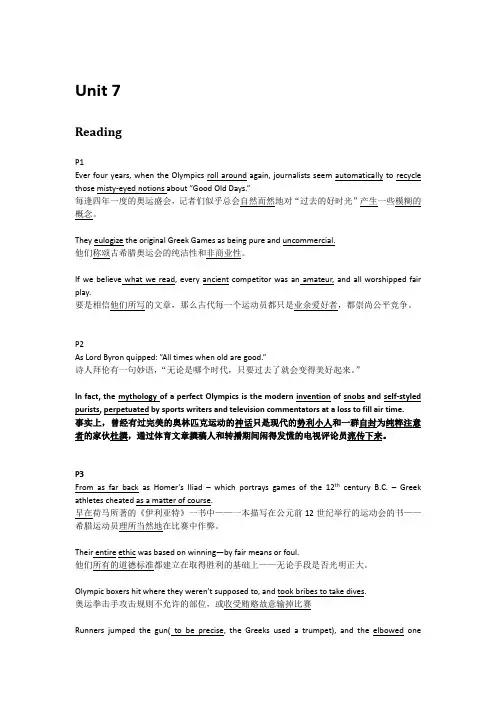
Unit 7ReadingP1Ever four years, when the Olympics roll around again, journalists seem automatically to recycle those misty-eyed notions about ”Good Old Days.”每逢四年一度的奥运盛会,记者们似乎总会自然而然地对“过去的好时光”产生一些模糊的概念。
They eulogize the original Greek Games as being pure and uncommercial.他们称颂古希腊奥运会的纯洁性和非商业性。
If we believe what we read, every ancient competitor was an amateur, and all worshipped fair play.要是相信他们所写的文章,那么古代每一个运动员都只是业余爱好者,都崇尚公平竞争。
P2As Lord Byron quipped: ”All times when old are good.”诗人拜伦有一句妙语,“无论是哪个时代,只要过去了就会变得美好起来。
”In fact, the mythology of a perfect Olympics is the modern invention of snobs and self-styled purists, perpetuated by sports writers and television commentators at a loss to fill air time.事实上,曾经有过完美的奥林匹克运动的神话只是现代的势利小人和一群自封为纯粹注意者的家伙杜撰,通过体育文章撰稿人和转播期间闲得发慌的电视评论员流传下来。
P3From as far back as Homer’s Iliad –which portrays games of the 12th century B.C. –Greek athletes cheated as a matter of course.早在荷马所著的《伊利亚特》一书中——一本描写在公元前12世纪举行的运动会的书——希腊运动员理所当然地在比赛中作弊。
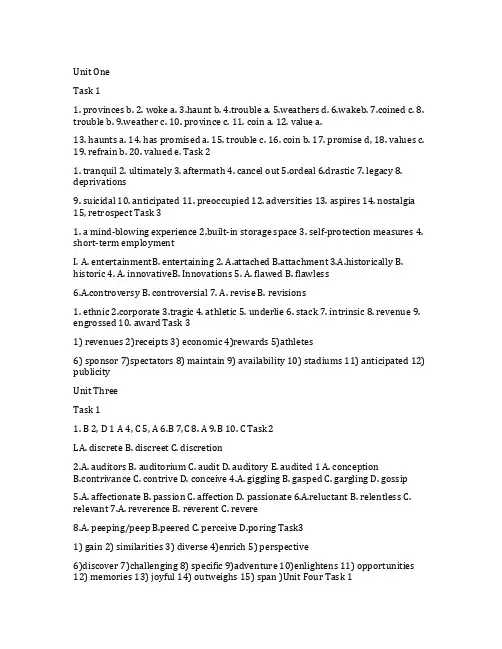
Unit OneTask 11. provinces b.2. woke a.3.haunt b.4.trouble a.5.weathers d.6.wakeb.7.coined c.8. trouble b.9.weather c. 10. province c. 11. coin a. 12. value a.13. haunts a. 14. has promised a. 15. trouble c. 16. coin b. 17. promise d, 18. values c.19. refrain b. 20. valued e. Task 21. tranquil2. ultimately3. aftermath4. cancel out5.ordeal6.drastic7. legacy8. deprivations9. suicidal 10. anticipated 11. preoccupied 12. adversities 13. aspires 14. nostalgia 15, retrospect Task 31. a mind-blowing experience2.built-in storage space3. self-protection measures4. short-term employmentI. A. entertainmentB. entertaining 2. A.attached B.attachment 3.A.historically B. historic 4. A. innovativeB. Innovations 5. A. flawed B. flawless6.A.controversy B. controversial7. A. revise B. revisions1. ethnic2.corporate3.tragic4. athletic5. underlie6. stack7. intrinsic8. revenue9. engrossed 10. award Task 31) revenues 2)receipts 3) economic 4)rewards 5)athletes6) sponsor 7)spectators 8) maintain 9) availability 10) stadiums 11) anticipated 12) publicityUnit ThreeTask 11. B 2, D 1 A 4, C 5, A 6.B 7,C 8. A 9.B 10. C Task2LA. discrete B. discreet C. discretion2.A. auditors B. auditorium C. audit D. auditory E. audited 1 A. conceptionB.contrivanceC. contriveD. conceive 4.A. giggling B. gasped C. gargling D. gossip5.A. affectionate B. passion C. affection D. passionate6.A.reluctant B. relentless C. relevant7.A. reverence B. reverent C. revere8.A. peeping/peep B.peered C. perceive D.poring Task31) gain 2) similarities 3) diverse 4)enrich 5) perspective6)discover 7)challenging 8) specific 9)adventure 10)enlightens 11) opportunities 12) memories 13) joyful 14) outweighs 15) span )Unit Four Task 11. D2.A3. B4.B5.D6. A7. C8. CTask 1 Step 1l)i 2)f 3)a 4)b 5)h 6)j 7)c 8)e 9)d 10)g Step 21)fidgety2)crushing3)pithy4) foraging5) definitive , 6)propelled7) applauded8) ubiquity9) duly10) curtail Task 21. above2.on3. to4.on5.on/about6. to 7 .with 8. at 9. on/about10. in Task 31. may have a subtle effect on2.provide free access toe-books3. isinthe midst ofa sea change4. has been onthe faculty ofHarvard University5.a voracious book reader6. you'll stay focused onit7. the conduit for information8.your check came asanabsolute godsend 9. lost the thread ofthe story 10. stroll through elegant proseUnit Five Task 11.A2.C3.D4.B5.C6.B7.C8.D9.A10.C11.B12D.13.D14.A15.BTask21.sheer2.slip3desert4. revenge5.sheered6. level7.deserted8.skirted9.protested10. duplicates11. level12. revenge13.skirt14. protests15.slip16.duplicateUnit Six Task 1I.C 2.A 3.C 4.A 5.D 6.C 7.B 8.D 9.A 10.C lI.B 12.ATask21. Water isnot an effective shield2.engulfed inflames3. the rights ofsovereign nations4. outpaced its rivals inthe market5. There's no need tobelabor the point6. She invoked several eminent scholars7. from two embattled villages8. According tothe witness's testimony 9. Inspite ofour best endeavors10. After many trials and tribulationsTask21) remain2) childish3)reaffirm4)precious5)equal6)measure7)greatness8) journey9)leisure10) fame11) obscure12) prosperityUnit SevenTask1I.C 2.B 3.B 4.D 5.B 6.C 7.C 8.A 9.B 10.BTask21. patrons b.2.designated b.3. reference d.4. inclination c5. host d.6. diffusing b.7. host c8.inclination a.9. references c.10. patrons a. 11. reference a.12. host a.13. diffuses a. .14. designate a.15. designate c.Task31) alive2)awakened3) trip4)stone5)remains6)beyond7)records 8)social 9)across10) surrounding11) mental12) miracle13) having 14) failure15) participateUnit Eight Task 11.B2.D3. A4.B5.A6. D7. D8.A9. A 10. C Task21. A. outburst B.bursting C. outbreak2.A. adverse B.adversity C. advised3.A. distinguishes B.distinct C. distinguished4.A. sight/vision B. view C. outlook D. visions5. A. implicit B.implicit/implied C. underlying。
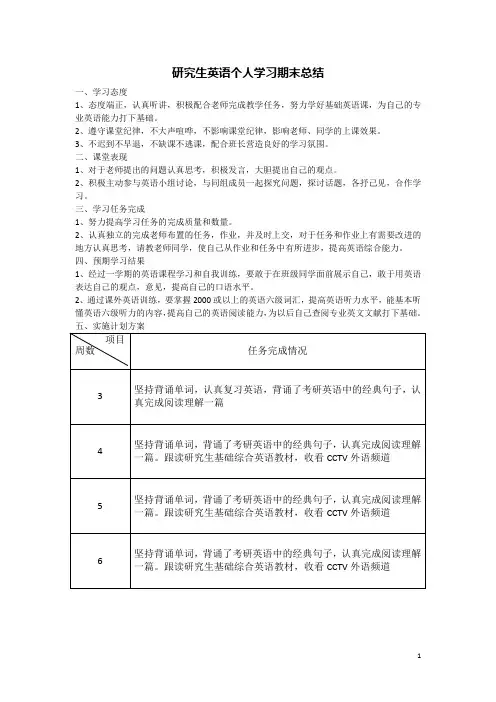
研究生英语个人学习期末总结
一、学习态度
1、态度端正,认真听讲,积极配合老师完成教学任务,努力学好基础英语课,为自己的专业英语能力打下基础。
2、遵守课堂纪律,不大声喧哗,不影响课堂纪律,影响老师、同学的上课效果。
3、不迟到不早退,不缺课不逃课,配合班长营造良好的学习氛围。
二、课堂表现
1、对于老师提出的问题认真思考,积极发言,大胆提出自己的观点。
2、积极主动参与英语小组讨论,与同组成员一起探究问题,探讨话题,各抒己见,合作学习。
三、学习任务完成
1、努力提高学习任务的完成质量和数量。
2、认真独立的完成老师布置的任务,作业,并及时上交,对于任务和作业上有需要改进的地方认真思考,请教老师同学,使自己从作业和任务中有所进步,提高英语综合能力。
四、预期学习结果
1、经过一学期的英语课程学习和自我训练,要敢于在班级同学面前展示自己,敢于用英语表达自己的观点,意见,提高自己的口语水平。
2、通过课外英语训练,要掌握2000或以上的英语六级词汇,提高英语听力水平,能基本听懂英语六级听力的内容,提高自己的英语阅读能力,为以后自己查阅专业英文文献打下基础。
五、实施计划方案。
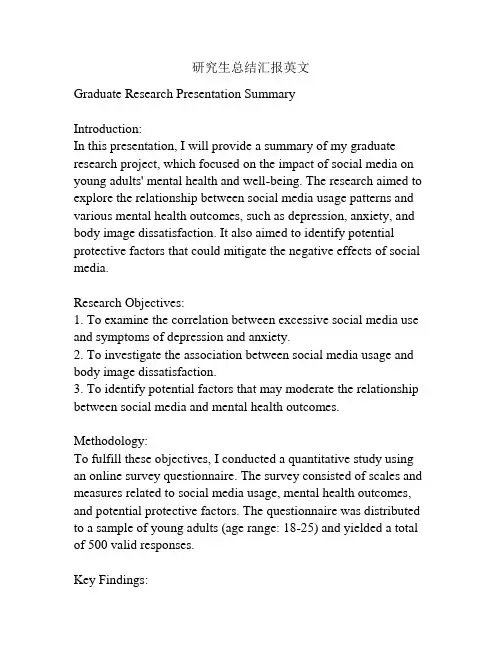
研究生总结汇报英文Graduate Research Presentation SummaryIntroduction:In this presentation, I will provide a summary of my graduate research project, which focused on the impact of social media on young adults' mental health and well-being. The research aimed to explore the relationship between social media usage patterns and various mental health outcomes, such as depression, anxiety, and body image dissatisfaction. It also aimed to identify potential protective factors that could mitigate the negative effects of social media.Research Objectives:1. To examine the correlation between excessive social media use and symptoms of depression and anxiety.2. To investigate the association between social media usage and body image dissatisfaction.3. To identify potential factors that may moderate the relationship between social media and mental health outcomes. Methodology:To fulfill these objectives, I conducted a quantitative study using an online survey questionnaire. The survey consisted of scales and measures related to social media usage, mental health outcomes, and potential protective factors. The questionnaire was distributed to a sample of young adults (age range: 18-25) and yielded a total of 500 valid responses.Key Findings:1. Excessive social media use was found to be positively correlated with symptoms of depression and anxiety. Individuals who reported spending more time on social media platforms also reported higher levels of these mental health issues.2. Significant associations were observed between social media usage and body image dissatisfaction. Participants who reported comparing themselves to others on social media platforms exhibited higher levels of body dissatisfaction.3. The presence of a strong support system, both online and offline, was found to play a significant role in mediating the negative effects of social media on mental health outcomes.Implications and Recommendations:The findings from this research project have several implications for mental health professionals, educators, and policymakers. Firstly, it highlights the need for increased awareness about the potential negative effects of excessive social media use, particularly among young adults. Addressing this issue should be incorporated into mental health prevention and intervention programs.Secondly, interventions aimed at promoting body positivity and media literacy can be effective strategies to reduce body image dissatisfaction related to social media. Educating young adults about the unrealistic nature of social media content and providing them with tools to critically evaluate and challenge these images can be beneficial.Lastly, fostering supportive online and offline networks is crucial in mitigating the negative impact of social media on mental health.Encouraging individuals to engage in positive online communities and establishing peer support programs can help create a sense of belonging and reduce feelings of isolation.Conclusion:To conclude, this research project provided insights into the relationship between social media usage patterns and mental health outcomes among young adults. The findings strongly suggest the need for proactive measures to address the potential negative impact of social media on mental well-being. By promoting awareness, implementing targeted interventions, and fostering supportive networks, we can create a healthier online environment for young adults.。
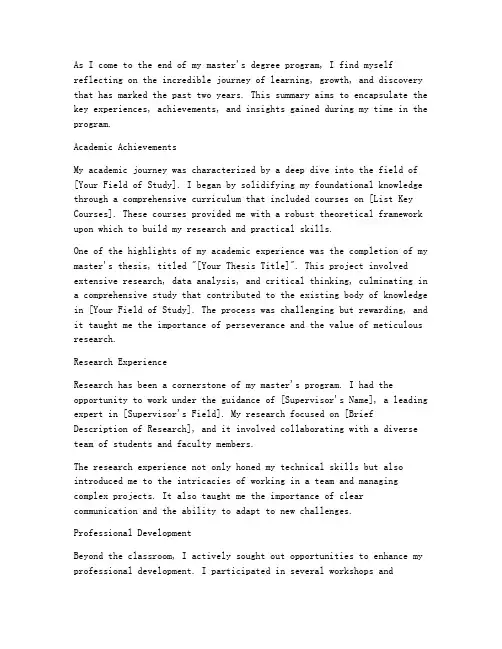
As I come to the end of my master's degree program, I find myself reflecting on the incredible journey of learning, growth, and discovery that has marked the past two years. This summary aims to encapsulate the key experiences, achievements, and insights gained during my time in the program.Academic AchievementsMy academic journey was characterized by a deep dive into the field of [Your Field of Study]. I began by solidifying my foundational knowledge through a comprehensive curriculum that included courses on [List Key Courses]. These courses provided me with a robust theoretical framework upon which to build my research and practical skills.One of the highlights of my academic experience was the completion of my master's thesis, titled "[Your Thesis Title]". This project involved extensive research, data analysis, and critical thinking, culminating in a comprehensive study that contributed to the existing body of knowledge in [Your Field of Study]. The process was challenging but rewarding, and it taught me the importance of perseverance and the value of meticulous research.Research ExperienceResearch has been a cornerstone of my master's program. I had the opportunity to work under the guidance of [Supervisor's Name], a leading expert in [Supervisor's Field]. My research focused on [Brief Description of Research], and it involved collaborating with a diverse team of students and faculty members.The research experience not only honed my technical skills but also introduced me to the intricacies of working in a team and managing complex projects. It also taught me the importance of clear communication and the ability to adapt to new challenges.Professional DevelopmentBeyond the classroom, I actively sought out opportunities to enhance my professional development. I participated in several workshops andseminars, including those on [List Relevant Workshops or Seminars]. These experiences provided me with practical skills and industryinsights that are invaluable for my future career.Additionally, I took on a teaching assistantship for a course in [Course Name]. This role allowed me to apply my knowledge in a teaching context, helping me develop my pedagogical skills and my ability to communicate complex concepts effectively.Personal GrowthThe master's program has been a transformative experience on a personal level as well. I have learned to manage my time more efficiently, tothink critically and analytically, and to approach challenges with a positive attitude. These skills have not only improved my academic performance but have also prepared me for the professional world.Future GoalsLooking forward, I am excited about the opportunities that lie ahead. I plan to pursue a career in [Your Desired Field], where I hope to apply the knowledge and skills I have acquired during my master's program. My ultimate goal is to make a meaningful contribution to the field of [Your Field of Study] and to continue my professional development through ongoing research and learning.In conclusion, my master's degree program has been an enriching and transformative experience. It has equipped me with the academic foundation, research skills, and professional competencies necessary to excel in my chosen field. I am grateful for the support of my professors, peers, and mentors, and I look forward to applying the lessons learnedto the next chapter of my life.。
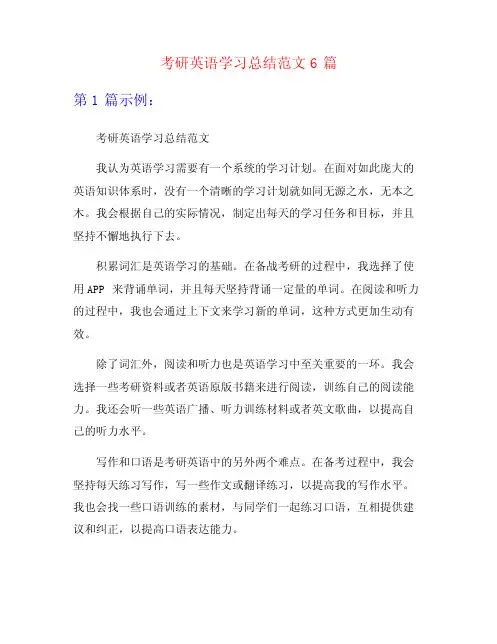
考研英语学习总结范文6篇第1篇示例:考研英语学习总结范文我认为英语学习需要有一个系统的学习计划。
在面对如此庞大的英语知识体系时,没有一个清晰的学习计划就如同无源之水,无本之木。
我会根据自己的实际情况,制定出每天的学习任务和目标,并且坚持不懈地执行下去。
积累词汇是英语学习的基础。
在备战考研的过程中,我选择了使用APP来背诵单词,并且每天坚持背诵一定量的单词。
在阅读和听力的过程中,我也会通过上下文来学习新的单词,这种方式更加生动有效。
除了词汇外,阅读和听力也是英语学习中至关重要的一环。
我会选择一些考研资料或者英语原版书籍来进行阅读,训练自己的阅读能力。
我还会听一些英语广播、听力训练材料或者英文歌曲,以提高自己的听力水平。
写作和口语是考研英语中的另外两个难点。
在备考过程中,我会坚持每天练习写作,写一些作文或翻译练习,以提高我的写作水平。
我也会找一些口语训练的素材,与同学们一起练习口语,互相提供建议和纠正,以提高口语表达能力。
考研英语学习需要不断总结与反思。
在备考的过程中,我会及时总结自己学习的经验与不足,并且调整学习方法与计划。
在考试前夕,我会进行模拟考试,检验自己的学习成果,找出漏洞与不足,以便在考试中更好的发挥。
英语学习是一个长期的过程,需要坚持和耐心。
希望我的经验与总结可以对正在备考考研的同学们有所帮助,也祝愿大家都能取得理想的成绩。
第2篇示例:考研英语学习总结随着社会的发展,考研已成为许多大学生继续深造的首选途径。
在考研过程中,英语学习一直是备受关注的重要部分。
在这一年的英语学习过程中,我积累了许多经验和体会,今天我将对自己的英语学习进行总结,希望对将来的考研学子有所启发。
对于英语学习,基础知识的掌握至关重要。
在备考阶段,要把握好英语基本语法和词汇,打好英语基础。
英语的基础知识是考研英语学习的基石,只有扎实的基础知识才能在后续的学习中游刃有余。
在备考阶段,我努力地背诵单词,练习语法,并通过做题来巩固所学知识。
研究生英文总结汇报IntroductionIn this report, I will summarize my research findings and present a comprehensive analysis of my graduate studies. The research I conducted aimed to investigate the impact of social media on consumer behavior and the effectiveness of different marketing strategies. This report will provide an overview of the research objectives, methodologies employed, key findings, and the significance of this study.Research ObjectivesThe main objective of the research was to explore the influence of social media on consumer behavior. This involved examining the role of social media in shaping consumer preferences, purchasing decisions, and brand loyalty. Additionally, the study sought to evaluate the effectiveness of various marketing strategies used on social media platforms, such as influencer marketing and user-generated content, on consumer engagement and purchase intentions.Methodologies EmployedTo achieve the research objectives, a combination of qualitative and quantitative methods were employed. Firstly, a literature review was conducted to provide a theoretical foundation for the study and to identify key trends and theories in the field of social media marketing. This was followed by the design of a survey questionnaire, which was distributed among a sample of consumers. The questionnaire consisted of both closed-ended and open-ended questions, allowing for both quantitative and qualitative data analysis.Key FindingsBased on the analysis of the collected data, several key findings emerged. Firstly, it was found that social media does have a significant impact on consumer behavior, with a majority of participants reporting that they are influenced by social media when making purchasing decisions. Additionally, the study revealed that consumers are more likely to trust recommendations from influencers and their peers when compared to traditional forms of advertising. This highlights the importance of incorporating influencer marketing and user-generated content into marketing strategies. Furthermore, the research found that interactive content, such as polls and quizzes, increases consumer engagement and purchase intentions.Significance of the StudyThis research contributes to the existing body of knowledge on social media marketing by providing empirical evidence on the influence of social media on consumer behavior and the effectiveness of marketing strategies. The findings can be used by marketers to refine their social media strategies and allocate resources effectively. Moreover, the study highlights the need for businesses to adapt to the changing landscape of marketing and embrace social media as a powerful tool for engaging with consumers.ConclusionIn conclusion, this research has shed light on the impact of social media on consumer behavior and the effectiveness of marketing strategies. The findings emphasize the importance of incorporatingsocial media into marketing campaigns and leveraging influencer marketing and user-generated content. As social media continues to play a significant role in consumers' lives, businesses must adapt their marketing strategies to remain competitive in the digital era. This study contributes to the understanding of social media's influence on consumer behavior and provides practical recommendations for marketers in harnessing the power of social media.。
第1篇一、前言随着我国高等教育的不断发展,考研人数逐年攀升,考研英语作为考研的重要组成部分,其重要性不言而喻。
本文将针对考研英语的学习过程,从词汇、语法、阅读、写作等方面进行总结,旨在为今后的考研英语学习提供有益的借鉴。
二、词汇积累1. 学习方法(1)制定合理的学习计划:根据自己的实际情况,制定一个切实可行的学习计划,将词汇学习融入日常生活,确保每天有一定的时间进行词汇学习。
(2)采用多种记忆方法:结合多种记忆方法,如词根词缀法、联想记忆法、卡片记忆法等,提高记忆效率。
(3)注重词汇运用:在阅读、写作等实际应用中,加强对词汇的运用,巩固记忆。
2. 学习心得(1)词汇是基础:词汇是英语学习的基础,只有掌握足够的词汇,才能更好地理解文章、表达思想。
(2)坚持长期记忆:词汇学习需要持之以恒,不能一蹴而就。
(3)注重语境记忆:在记忆词汇时,要结合语境进行记忆,提高词汇的运用能力。
三、语法掌握1. 学习方法(1)系统学习语法知识:掌握英语的基本语法规则,如时态、语态、非谓语动词等。
(2)多做语法练习:通过大量的语法练习,提高对语法知识的运用能力。
(3)分析错误:在练习中发现错误,分析错误原因,总结经验教训。
2. 学习心得(1)语法是框架:掌握语法知识,有助于构建英语表达的框架。
(2)语法是工具:熟练运用语法知识,可以更好地表达自己的思想。
(3)不断巩固:语法知识需要不断巩固,以免遗忘。
四、阅读理解1. 学习方法(1)广泛阅读:阅读各类英语文章,提高阅读速度和理解能力。
(2)掌握阅读技巧:如快速浏览、定位信息、归纳总结等。
(3)分析文章结构:了解文章的写作思路,有助于理解文章内容。
2. 学习心得(1)阅读是关键:阅读理解是考研英语的重中之重,提高阅读能力是取得高分的关键。
(2)培养阅读兴趣:阅读可以拓宽视野,培养阅读兴趣有助于提高阅读能力。
(3)注重积累:通过阅读,积累词汇、语法、写作等方面的知识。
五、写作能力1. 学习方法(1)掌握写作技巧:如文章结构、段落组织、句子连接等。
随着硕士阶段的英语学习即将结束,回首这段时间的学习历程,我深感收获颇丰,同时也意识到自己在学习过程中存在的不足。
以下是我对硕士英语学习的一次总结与反思。
一、学习收获1. 扩大了词汇量在硕士英语学习中,我注重积累词汇,通过阅读、听力、口语和写作等多种途径,不断扩大自己的词汇量。
这不仅使我在学术交流中更加自信,也为今后的学术研究打下了坚实的基础。
2. 提高了听力水平通过大量的听力练习,我逐渐掌握了英语听力技巧,能够较快地捕捉到关键信息,提高了听力理解能力。
在学术讲座、国际会议等场合,我能够更加从容地与外教和同行进行交流。
3. 增强了口语表达能力在口语方面,我积极参加英语角、学术讲座等活动,与外教和同学进行互动。
通过不断地练习,我的口语表达能力得到了很大提升,能够更加流畅地表达自己的观点。
4. 提升了写作能力在写作方面,我遵循老师的要求,反复修改自己的论文,力求使文章结构清晰、逻辑严谨。
通过不断地练习,我的写作能力得到了很大提高,能够撰写出高质量的学术论文。
二、反思与不足1. 学习方法不够灵活在学习过程中,我发现自己在某些时候学习方法较为单一,没有根据实际情况调整学习策略。
例如,在阅读方面,我过于依赖词典,导致阅读速度较慢。
在今后的学习中,我需要更加灵活地运用学习方法,提高学习效率。
2. 时间管理能力有待提高在硕士阶段,我面临着诸多压力,如课程、论文、实习等。
在这个过程中,我发现自己在时间管理方面存在一定问题,导致学习效果受到影响。
在今后的学习中,我需要合理安排时间,提高时间利用效率。
3. 自主学习能力不足虽然我在硕士阶段取得了一定的成绩,但自主学习能力仍有待提高。
在今后的学习中,我需要培养自己的自主学习能力,主动探索知识,提高自己的综合素质。
4. 缺乏实践机会在英语学习中,实践机会的缺乏使我无法将所学知识应用于实际生活。
在今后的学习中,我需要主动寻找实践机会,将所学知识付诸实践。
三、未来展望1. 继续扩大词汇量,提高英语水平。
Unit One 课后汉译英TranslationWhen I first came into contact with online teaching, I had questions about the validity of this instructional medium.I would not know whether the student submitting the work was the same person who registered for the course.Online teaching also required rethinking how I deliver the subject matter. Without face-to-face communication, can I, via computer, make the students feel the same kind of enthusiasm and appreciate my sense of humor?My shy daughter’s experience proved to be very inspiring. She never spoke in class, but in the two online courses she took, she dived into discussions and posted her opinions.The online course began and things ran better than I had expected. The students all followed the directions well, and the discussion board was lively. I’ve never met any of my students but I got to know them by their work and I saw their learning attitudes develop before my eyes.I found that online education worked best with students who were very comfortable with the computer and willing to become part of a community built around the subject matter. And it required teachers to be willing to help build that sense of community and make the students feel the teacher was always there.英译汉---课文选段Since I was scheduled to teach environmental science in summer school, it seemed like the perfect time to write the lectures for the online course in the fall. My plan: On the day I had to deliver a traditional lecture, I’d just type it up i n the morning, cut the grass, then teach the class in the evening.8.因为要在暑期学校讲授环境科学课,趁这机会为秋季的网络课程备课看来再合适不过了。
研究生英语课程总结研究生英语课程是大多数研究生必须要学习的课程之一。
这门课程通常包括阅读、写作、听力、口语和语法等多个方面,旨在提高学生的英语水平和专业能力。
在这门课程中,我学到了很多有用的知识和技能,以下是我的总结和拓展。
阅读方面:研究生英语课程的阅读量相当大,需要学生具备良好的阅读能力和快速阅读技巧。
通过这门课程,我学到了如何快速准确地理解英文文章,掌握了阅读理解的技巧和方法,并且能够运用所学知识,提高自己的阅读水平。
写作方面:研究生英语课程中的写作主要包括学术论文和学术报告。
在这门课程中,我学会了如何撰写学术论文,如何进行学术写作,以及如何参考文献和文献引用等重要内容。
我也了解了英文写作的结构和流程,掌握了写作技巧和方法。
听力方面:研究生英语课程的听力部分通常包括听力训练和听力理解。
通过这门课程的学习,我提高了自己的听力水平,学会了如何听懂不同口音和语速的英语,并且能够准确理解听力材料中的重点信息。
口语方面:研究生英语课程中的口语主要包括发音、口语表达和口语交际等内容。
通过这门课程,我学会了如何发音准确、流畅,如何有效表达自己的意思,以及如何在不同场合下进行口语交际。
语法方面:研究生英语课程中的语法部分是学生必须要掌握的重点内容之一。
通过这门课程,我学习了英语语法的基础知识、语法规则和常见错误,掌握了如何正确使用英语语法,提高了自己的语言表达能力。
总体来说,研究生英语课程是非常重要的一门课程,对于提高学生的英语水平和专业能力都有很大的帮助。
通过这门课程的学习,我不仅掌握了英语的基础知识和技能,而且提高了自己的综合素质,在今后的学习和工作中都会有很大的帮助。
考试题型:一.回答问题二.文体对比stylistic features: subjective(主观的)/objective(客观的)三.语篇分析---textual development /analogy四.语篇改写句子和句子之间衔接词语少了There are numerous reasons for……at first, …….secondly, ….In addition, /additionally,/furthermore, …/what is more,Unit 1 General Introduction to Professional Paper Writing1.1 Classification of professional paperA professional paper is a formal printed document in which professionals present their views and research findings on any deliberately chosen topic.1)Report paper读书报告2)Research paper 研究论文3)Course paper课程论文4)Thesis paper(Dissertation)学术论文1.2 General Characteristics of English Academic Writing StyleGenerally, English Academic writing is:1) complex(复杂)--Written language is relatively more complex than spoken language2) formal(正式)--Academic writing is relatively formal. Formal writing doesn’t use contractions, colloquialisms and slang.3) impersonal and objective(客观)--Written language is in general objective rather than personal. It therefore has fewer words that refer to the writer or the reader. This means that the main emphasis should be on the information that you want to give and the arguments you want to make, rather than you.4) explicit(清楚)--Academic writing is explic it about the relationships in the text. Furthermore, it is the responsibility of the writer in English to make it clear to the reader how the various parts of the text are related.5) accurate(准确)--Academic writing uses vocabulary accurately. Most subjects have words with narrow specific meanings.6) cautious or tentative(用词谨慎)7) responsible(负责)---Academic writing refers to information from a range of print, digital and other sources, all of which must be clearly referenced in your text references other writers’ work. Question & Exercises:Read the following two passages and try to find out the stylistic features of each.Answer:Compared with these two passages, I find that there are differences in styles,passage 1 is informal, subjective, for example: ―I’m......‖,―don’t......‖While the second passage is a scientific research paper, it’s formal, objective and complex, for example,(长句,被动语态等)(subjective---objective, simple---complex, for example......)Unit 2 Title, Author/Affiliation and Keywords2.1 Titles2.1.1. General functions1). Generalizing the Text (总结全文)2). Attracting the Reader (吸引读者)3). Facilitating the Retrieval (方便检索)2.1.2.Linguistic Features做分析题时候,可以根据下面的格式进行分析。
1) Using More Nouns, Noun Phrases and Gerunds(使用名词、名词短语和动名词)The words or phrases used in a title are very often nouns, noun phrases or gerunds, nominalization, which usually are keywords for the paper, having the ability to sum up the whole text.For example, we may easily find such titles as: 句子背不下来就不要用(1)Working mechanism application of LED(2) Civilization's Source and Its Implication.(3) A Multi-perspective Account of Met linguistic Negation.(4) Research on the Motivations of Lexis and V ocabulary Learning Strategies.2) Using Incomplete Sentences(使用不完整的句子)A title is just a label of appellation of the paper, reflecting the main idea of the content, so even when there is a need to give a title in the form of a sentence, it does not need to be a complete sentence.For example, “意识形态是文化的特殊样态”.2.3 Keywords2.3.1 General Functions:A. Easiness of Retrieval (检索方便)B. Easiness of Highlighting(突出醒目)2.3.1 Linguistic FeaturesA. Nominalization (名词化): Keywords are usually used in the form of nouns, not verbs. For example, investigate -- investigation; fabricate -- fabrication; educate -- education.B. Limited Number (关键字数目有限): The number of the keywords for a paper should be limited. Min – max (2-8), average (4-6).C. Designated Choice (不能随意选择): The keywords of a paper usually come from the title and/or the abstract.ExercisesCorrect the mistakes in the following titles according to the writing requirements you've learnt in this unit.1. Digital Laser Micro interferometer and Its Applying. (Applying----Application)2. Measuring of Surface Shape and Deformation by Phase-shifting Image Digital Holography. (Measuring---Measurement)3. The Effects of the Patient Age and Physician Training on the Choice and Dose of Anti-melancholic Drugs. (去掉所有的“the”)4. Scope of the Investigations: the First Phase. (去掉第一个“the”)5. A New Broadband Uniform Accuracy DOA Estimator. (DOA---标题不具体,太宽泛extensive)Unit 3 Abstract一般出现下面问题时,可以从如下几点回答:(1)Comment on the following abstract(2)Analyze the following abstract?Answer :a, Complex(复杂)--sentences’ structure .b, Objective(客观)--no personal pronoun is used in the abstract above.c, The active voice is commonly used in it .(主动语态)d, The information of an abstract is arranged in one paragraph .(一个段落)(3)Analyze the problems exiting in the following abstract?Answer : a, Informal(不正式) -For example, ”I think”.b, Over-simplified Statements(表述过分简单)c, Monotonous Expression(单一的表达)d, Mixed writing stylee, Incomplete contents(内容不完整)f, Displacement of information(摘要各成分之间顺序混乱,篇幅不合理)1. 语态单一(全主动或全被动)2. 口语化3. 太过简单和复杂4. 摘要各成分之间顺序混乱5. 摘要各成分之间篇幅不合理3.1. Definition of AbstractAn abstract is a brief and self-contained summary and an accurate representation of the contents of a document such as a research paper, a journal article, thesis, review, conference proceeding, and other academic documents.The purpose of an abstract is to provide prospective readers the opportunity to judge the relevance of the longer work of their projects.3.4. Classification of AbstractsDepending on which information they contain, abstracts can be classified into major types: indicative (or descriptive) abstracts, informative abstracts, indicative - informative abstracts and author abstracts.descriptive abstract 把问题进行了概述但对研究结果未提及,而在informational abstract 中提供了主要研究结果。